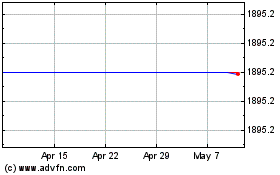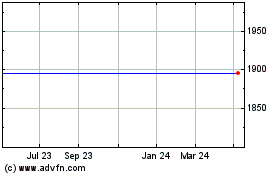Shell Girds for 'Lower Forever' Oil -- WSJ
July 28 2017 - 3:02AM
Dow Jones News
By Sarah Kent
This article is being republished as part of our daily
reproduction of WSJ.com articles that also appeared in the U.S.
print edition of The Wall Street Journal (July 28, 2017).
LONDON -- Royal Dutch Shell PLC presented a pessimistic vision
for the future of oil on Thursday, even as the company reported
success in generating cash during a prolonged energy downturn.
Shell has cut costs and said it is preparing for a world in
which crude prices may never regain precrash levels and petroleum
demand eventually declines. Shell Chief Executive Ben van Beurden
said the company has a mind-set that oil prices would remain "lower
forever" -- a riff on the "lower for longer" mantra the industry
adopted for a price slump that has proved unexpectedly lasting.
"We have to have projects that are resilient in a world where
oil has peaked," Mr. van Beurden told reporters on a conference
call discussing the company's second-quarter financial results.
"When it will happen we don't know, but that it will happen we are
certain."
The views of the British-Dutch oil company reflect the
transition under way in a global energy industry grappling with the
twin forces of an oil-supply glut and a looming consumer shift away
from petroleum. These trends are even more pronounced for oil
companies in Europe, where local and national governments are
trying to phase out vehicles with internal-combustion engines,
encourage electric automobiles and reduce overall carbon
emissions.
Experts differ on the timing of peak oil demand. In its
most-guarded scenario, Shell sees oil peaking within the coming
decade. The International Energy Agency says the timing will be
more like 2040. The advent of declining demand -- after decades of
unrelenting growth -- would likely erode the value of oil and the
companies that produce it.
On the other hand, U.S. energy giants such as Exxon Mobil Corp.
and Chevron Corp. have said peak oil demand is still far off. And
even when oil consumption eventually stops growing, Shell isn't
expecting it to drop off a cliff.
"It doesn't mean it's game over straight away," Mr. van Beurden
said. "There will be a continued need for investment in oil
projects."
Mr. van Beurden's comments are broadly in line with Shell's
overall strategy of moving toward producing fuel for electricity,
such as natural gas and even renewables, and focusing on keeping
costs low. The company now produces more gas than oil. It is also
building a massive wind farm off the Dutch coast and envisions
spending as much as $1 billion a year on developing new energy
sources such as renewables by the end of the decade.
Despite Shell's warnings on oil, the company posted what
analysts said was a strong second quarter.
Shell's equivalent of net profit rose to $1.9 billion from $239
million a year earlier and its cash flow from operations -- a
metric that has become increasingly important to investors --
soared to $11.3 billion. The company said it generated $38 billion
of cash from its business over 12 months, enough to cover dividend
payments and pare debt.
French oil giant Total SA and Norway's Statoil ASA also reported
their quarterly results on Thursday, both striking a confident if
cautious note. They trumpeted falling debt levels and strong cash
flow.
Total's profit for the quarter was $2 billion, roughly the same
as last year, while the company reported a significant increase in
cash flow from operations to $4.6 billion.
Statoil said it earned $1.4 billion, compared with a loss of
$302 million in last year's second quarter. The company said it
generated $4 billion in free cash flow.
Exxon and Chevron report earnings on Friday.
Cash flow has become an important way to gauge the health of big
oil companies during the price downturn because it demonstrates
their ability to make dividend payments to investors without taking
on new debt.
Hefty, regular dividends are a significant reason big investors
put money in oil companies, which historically haven't held out
much hope of significant share-price growth because of their size.
Investors are particularly wary in an era of low oil prices.
At the depths of the oil-price crash, big oil companies took on
tens of billions of dollars in debt to help cover dividend
payments. Several offer payouts as company shares, known as scrip
-- a practice that has kept investors happy in the short-term but
was widely seen as unsustainable.
In the first quarter of last year when oil hit its nadir of $27
a barrel, Shell's cash flow fell to just $700 million. Oil's
fragile recovery since then to around $50 a barrel has helped the
sector, but Shell and its peers have also engaged in aggressive
efforts to bring down costs so they can survive at lower prices.
Shell said that removing its scrip dividend remains a priority that
it is working toward.
"We are getting fit for the 40s," Mr. van Beurden said,
referring to a world in which oil prices are below $50 a
barrel.
Write to Sarah Kent at sarah.kent@wsj.com
(END) Dow Jones Newswires
July 28, 2017 02:47 ET (06:47 GMT)
Copyright (c) 2017 Dow Jones & Company, Inc.
Shell (LSE:RDSA)
Historical Stock Chart
From Aug 2024 to Sep 2024

Shell (LSE:RDSA)
Historical Stock Chart
From Sep 2023 to Sep 2024
